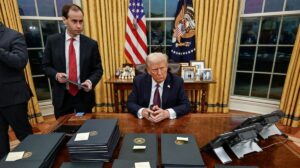In an effort to streamline federal governance, President Trump has issued a memorandum directing agencies to align regulations with Supreme Court rulings to eliminate unlawful regulations, while promoting competition and innovation in the economy.
Trump Directs Federal Agencies to Repeal Regulations Following Supreme Court Rulings

Trump Directs Federal Agencies to Repeal Regulations Following Supreme Court Rulings
The President's new memorandum mandates a review and repeal of regulations deemed unlawful in light of recent Supreme Court decisions.
In a bold effort to reshape federal regulatory frameworks, President Donald J. Trump has issued a Presidential Memorandum aimed at instructing executive departments and agencies to pinpoint and repeal regulations identified as unlawful according to ten pivotal Supreme Court rulings. This initiative builds on Executive Order 14219, known as “Ensuring Lawful Governance and Implementing the President’s ‘Department Of Government Efficiency’ Deregulatory Initiative,” which was signed on February 19, 2025.
The memorandum highlights the necessity for federal agencies to align their regulations with constitutional limits set forth by the Supreme Court. Key rulings, including West Virginia v. EPA, Loper Bright Enterprises v. Raimondo, and SEC v. Jarkesy, have curtailed broad interpretations of agency authority, reinforcing the importance of following strict legislative guidelines.
To facilitate a swift repeal process, the memorandum allows agencies to leverage the “good cause” exception stipulated in the Administrative Procedure Act (APA). This provision enables agencies to bypass the typical notice-and-comment rulemaking process necessary for repealing regulations that oppose the specified Supreme Court decisions, thereby minimizing bureaucratic delays and promoting efficiency.
Furthermore, President Trump has instructed the Federal Trade Commission (FTC) to lead a government-wide initiative focused on rescinding or amending federal regulations that impede competition, entrepreneurship, and innovation. This initiative extends beyond the FTC’s conventional role, targeting all federal regulations that may have adverse competitive effects, thus fostering a more agile and competitive economic landscape.
Agencies are tasked with conducting a 60-day review of existing regulations to evaluate compliance with the Supreme Court decisions. They are expected to promptly undertake actions to repeal or amend regulations that surpass statutory authority or are identified as unlawful. This collective effort illustrates the administration's dedication to ensuring that federal regulations conform to constitutional and legislative guidelines.
President Trump’s directive symbolizes a substantial shift towards reinforcing legal compliance within federal regulatory practices. By aligning agency protocols with recent Supreme Court rulings and expediting the removal of illegal regulations, the administration seeks to maintain a more accountable and constitutionally sound federal bureaucracy.























